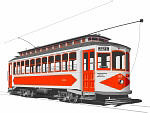 Schuylkill Valley Traction Co.
Schuylkill Valley Traction Co. Schuylkill Valley Traction Co.
Schuylkill Valley Traction Co.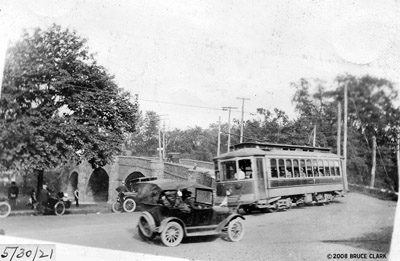
|
|
Date: May 30, 1921 |
Trolley service in Norristown was provided by two systems: the Reading Transit & Light Company, which ended trolley service in 1933, and the Lehigh Valley Transit Company, whose Liberty Bell Route served the borough from 1912 through 1951. This article will focus on the RT&L.
In 1895, local Norristown streetcar lines were consolidated as the Schuylkill Valley Traction Company. The trolley lines provided frequent streetcar service on several routes in the borough; suburban trolley service linked Norristown and surrounding communities including Bridgeport, Swedeland, Collegeville, Conshohocken and Chestnut Hill. West beyond Collegeville, trolleys ran to Limerick, Pottstown and Boyertown. In 1908, wrote Harry Foesig in Trolleys of Montgomery County Pennsylvania, "Interstate Railways Company of Philadelphia obtained control of 16 electric railways including the United Traction Company of Reading which in turn included the Oley Valley and the Schuylkill Valley and the whole was reorganized as the Reading Transit Company." In 1913 yet another corporate re-shuffling resulted in the name Reading Transit & Light, or RT&L for short.
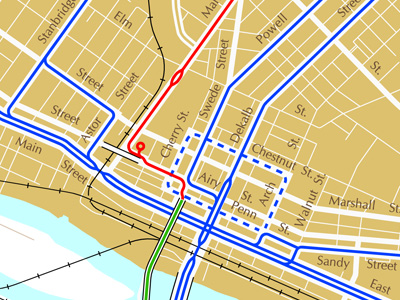 In towns, the trolleys ran in the
middle of the streets,
with the density of service on Main Street in Norristown requiring two sets
of rails. Between towns the trolleys ran both ways on a single track, on the
shoulder of the highway. Electric signal lights and frequent passing sidings
allowed opposing trolleys to pass safely. When the land adjacent to the tracks
was developed, a parallel frontage road was built to access the new properties.
These frontage roads are still visible in two places around Norristown: Hartranft
Drive along West Main Street between Montgomery Avenue and Schuylkill Avenue
in West Norriton Township; and Oakland Boulevard along Sandy Hill Road near
Fairfield Avenue in Plymouth Township (see photo below).
In towns, the trolleys ran in the
middle of the streets,
with the density of service on Main Street in Norristown requiring two sets
of rails. Between towns the trolleys ran both ways on a single track, on the
shoulder of the highway. Electric signal lights and frequent passing sidings
allowed opposing trolleys to pass safely. When the land adjacent to the tracks
was developed, a parallel frontage road was built to access the new properties.
These frontage roads are still visible in two places around Norristown: Hartranft
Drive along West Main Street between Montgomery Avenue and Schuylkill Avenue
in West Norriton Township; and Oakland Boulevard along Sandy Hill Road near
Fairfield Avenue in Plymouth Township (see photo below).
The center of operations for the Schuylkill Valley trolley system was Riverside
car barn, located on West Main Street at Montgomery Avenue, in West Norriton
Township. After the trolley system was abandoned in 1933, this large car barn,
with its brick walls and wood-truss roof, was used as a pretzel factory. It
was destroyed in a spectacular fire on July 9, 1944. A low stone retaining wall
at the edge of Montgomery Avenue is all that remains. Currently, a taxi garage
occupies the front portion of the property.
The trolleys used on this system were typical city / suburban cars. Because the Schuylkill Valley system and the Reading Transit Company were owned by the same utility company, the trolleys were often swapped between Norristown and Reading. The trolley used in the title graphic was built by Brill in 1902; others were purchased in 1912 through 1918. The massive express trolleys that ran from Chestnut Hill to Boyertown were large enough to be railroad passenger cars. Until 1926, freight trolleys operated along Main Street, between Reading and Philadelphia, with a freight terminal located on Penn Street. During the 1920's, small, second-hand Birney cars were acquired.
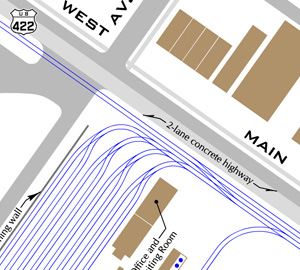 Reading Transit & Light Co. was the company that operated the Schuylkill Valley
Traction Company and the Roxborough, Chestnut Hill and Norristown trolley lines.
During the 1910's and 1920's the trolley system was often referred to simply
as the RT&L.
Reading Transit & Light Co. was the company that operated the Schuylkill Valley
Traction Company and the Roxborough, Chestnut Hill and Norristown trolley lines.
During the 1910's and 1920's the trolley system was often referred to simply
as the RT&L.
Largely forgotten today, is the fact that these trolleys were clean transportation. In marked contrast to the diesel-burning buses which SEPTA operates in Montgomery County today, the RT&L trolleys utilized renewable energy. Beginning in 1914 the trolleys were powered by a hydro-electric plant at Lock 60 on the Schuylkill River near Phoenixville. Follow this link for more information.
With the onset of the Great Depression in 1930, RT&L cancelled the leases of the subsidiary trolley companies. Therefore local trolleys in Norristown were once again Schuylkill Valley Traction trolleys. Chestnut Hill to Norristown (and Pottstown to Norristown) service again became Roxborough, Chestnut Hill & Norristown.
The Commonwealth of Pennsylvania began paving the highway network in the 1920s,
and this coupled with increased private automobile ownership meant fewer trolley
riders. When the SVT sold off its newer Birney cars in 1930, the older (1903)
trolleys came back into regular use. Some of the old streetcars were given a
bright new paint job, consisting of light beige-cream with a large red diamond
on the ends and sides. However, by that time the tracks were in poor condition,
and would have been expensive to upgrade. Public subsidies were poured into
highway building, but not public transportation. It became easier and cheaper
for transit companies to run buses on streets and highways whose construction
and maintenance was paid for by others. Buses took over on September 10, 1933.
This 1905 postcard is a hand-tinted
photograph looking west on Main Street from the intersection with Dekalb
Street.
The Brill semi-convertible trolley wears the green and cream paint of
the Schuylkill Valley Traction Company. The large brick building at right is the Norristown
Trust Company. Note the bicyclist riding between the rails, following the trolley.
This postcard was kindly made available by C. Pupek
This is Germantown Avenue at Northwestern Avenue in Chestnut Hill, circa 1910. Photographer is standing in Philadelphia, looking across Northwestern Avenue into Montgomery County. This is the point where passengers transferred between Philadelphia Rapid Transit Co. trolleys, and Norristown trolleys. This Schuylkill Valley Traction Company trolley is signed for Trooper, a small town three miles above Norristown. Freight trolleys passed through this point, running on the tracks of both systems. PRT Route 23B trolleys were replaced by the Route X bus in 1928; in late1931 the suburban trolleys would also be replaced by buses.
The restaurant at left is still in business, today known as Bruno's.
A sunny Saturday morning in the spring of 1932 finds Schuylkill Valley no.
119 headed eastbound on Ridge Pike in Trooper, PA, returning from Collegeville.
The 1903 Brill suburban car is signed for Main & Ford Streets. This location
is just west of the intersection of Ridge Pike and Park Avenue. When this photo
was made, suburban sprawl hadn't yet reached Lower Providence Township. Ridge
Pike was a two-lane highway through mostly undeveloped countryside. Today this
location is congested with automobile traffic; the lawn in the photo is now
the asphalt parking lot of a Walgreens pharmacy.
SVT no. 119 eastbound at Trooper on May 14, 1932
William Watts II photographed RCH&N trolley changing ends before
returning to Chestnut Hill, at Main and Astor Streets in Norristown. Never painted
into the modern paint scheme, the color of this 1901 Brill-built trolley is
green and cream. The stone parapet of the Main Street bridge over Stony Creek
is visible at right; the brick buildings in the background still stand today.
Date written on the back of the photo is 11-12-31. Trolley service between Chestnut
Hill and Norristown would end all too soon, on December 13, 1931.
R. Short Collection, used with permission
William H. Watts II snapped this photo of SVT no. 117 at Riverside car barn
on West Main Street on December 12, 1931. That was the next-to-last day for
trolley service between Norristown and Chestnut Hill. The trolleys would continue
to run to Bridgeport, Swedeland, Conshohocken and Collegeville for two more
years. (The houses across the street still stand, between a 7-11 and a dry cleaner
on Main Street.)
Reading Transit & Light Co. Birney car no. 508 moves away from
the camera, northbound on Dekalb Street Norristown, between Lafayette Street
and Main Street in 1930. In the foreground are the electrified tracks of the
Pennsylvania Railroad, which would soon be removed from Lafayette Street and
placed on a new bridge over Dekalb Street (currently utilized by the Schuylkill
River Trail). The wire basket along the overhead trolley wire was designed to
allow the trolley to continue off the railroad grade crossing in the event the
trolley pole came off the wire. After the Norristown trolley lines became bus
routes in 1933, this trolley was taken to the city of Reading where it served
for many more years.
Andrew W. Maginnis collection
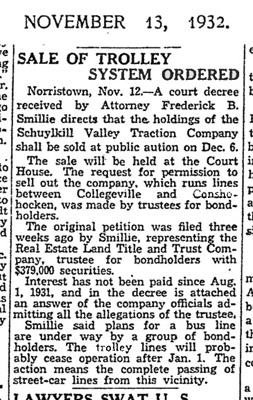
SALE OF TROLLEY SYSTEM ORDERED
Norristown, Nov. 12. -- A court decree received by Attorney Frederick B. Smillie directs that the holdings of the Schuylkill Valley Traction Company shall be sold at public auction on Dec. 6 [1932].
The sale will be held at the Court House. The request for permission to sell out the company, which runs lines between Collegeville and Conshohocken, was made by trustees for bondholders.
The original petition was filed three weeks ago by Smillie, representing the Real Estate Land Title and Trust Company, trustee for bondholders with $379,000 securities.
Interest has not been paid since Aug. 1, 1931, and in the decree is attached an answer of the company officials admitting all the allegations of the trustee.
Smillie said plans for a bus line are under way by a group of bondholders. The trolley lines will probably cease operation after Jan. 1. The action means the complete passing of street-car lines from this vicinity.
November 13, 1932
The last day for RT&L / SVT trolley service in Norristown
was September 9, 1933. Here is the last car, at Riverside car barn, West
Main Street at Montgomery Avenue.
(Lehigh Valley Transit Company trolleys continued
running on Airy and Markley Streets in Norristown until 1951.)
Harry Foesig collection, courtesy of Andrew W. Maginnis
Just days after the end of trolley service, Montgomery County commissioners announced that the old roadside trolley right-of-way would be used to widen Ridge Pike in Plymouth Township, and Butler Pike between Ridge Pike and Conshohocken. Earlier newspaper editorials complained that Butler Pike was too narrow to safely accomodate automobiles, trolleys and pedestrians. Looking back today, the 1933 decision to widen to the road to four lanes and get rid of the trolley tracks did indeed benefit motorists, but did nothing for pedestrians and bicyclists.
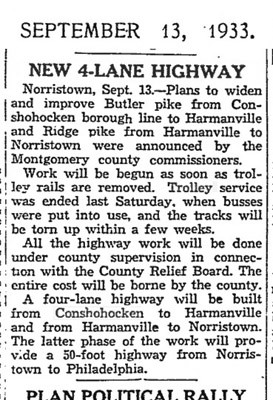
NEW 4-LANE HIGHWAY
Norristown, Sept. 13. -- Plans to widen and improve Butler pike from Conshohocken borough line to Harmanville and Ridge pike from Harmonville to Norristown were announced by the Montgomery County commissioners.
Work will begin as soon as trolley rails are removed. Trolley service was ended last Saturday, when busses were put into use, and the tracks will be torn up within a few weeks.
All the highway work will be done under county supervision in connection with the County Relief Board. The entire cost will be borne by the county.
A four-lane highway will be built from Conshohocken to Harmanville and from Harmanville to Norristown. The latter phase of the work will provide a 50-foot highway from Norristown to Philadelphia.
September 13, 1933
(Harmonville is the village that stood at the corner of Ridge Pike and Butler Pike, on the Whitemarsh-Plymouth township boundary.)
Although it hasn't seen trolley service in many years, the trolley
right-of-way along Sandy Hill Road in Plymouth Township is still visible. When
the Pennsylvania Department of Highways rebuilt the road with concrete in 1929,
the road was designed to run alongside the trolley tracks which remained in
service through 1931. This was a common arrangement for local trolley lines,
with trolleys travelling both directions on a single track, on the same side
of the road. This photo looks west, toward Norristown, at Plymouth Boulevard.
October 1996 photo by Mike Szilagyi
The descendent of SVT, the Schuylkill Valley Lines, operated buses in and
around Norristown until bought out by the regional transit authority, SEPTA,
in the mid-1970's. SEPTA inherited a small fleet of short "old look" GM buses
from the Schuylkill Valley Lines, and continued to operate them into the early
80's, alongside ex-Red Arrow Lines buses. The rollsign in this photo shows that
the new 90-series routes are in use, and a SEPTA Frontier decal has been slapped
on the side of the coach, above the front wheel.
Ex-Schuylkill Valley 784 on Swede Street in front of the Montgomery County
Court House on June 16, 1977. Mike Szilagyi photo.
Just as Reading Transit & Light Company did half a century earlier, SEPTA
applied a bold paint scheme to old equipment in an effort to increase visibility
and ridership. Here an old-look GM coach wears the new paint scheme of Frontier
Division. No other coaches were so painted. Actually this coach is not as old
as it looked; GM built coaches based on this 1940 design through the 1960's.
An all-time roster of these short "last of the old-looks" is available at The
Ohio Museum of Transportation.
This particular coach was built in 1964 for Burlington (Vermont) Rapid Transit
Co., and was acquired by the Schuylkill Valley Lines in 1966.
Ex-BRTCo. ex-Schuylkill Valley 1964 GM TDH3501 at Frontier Division depot
on Trooper Road, W. Norriton, on May 27, 1977. Mike Szilagyi photo.